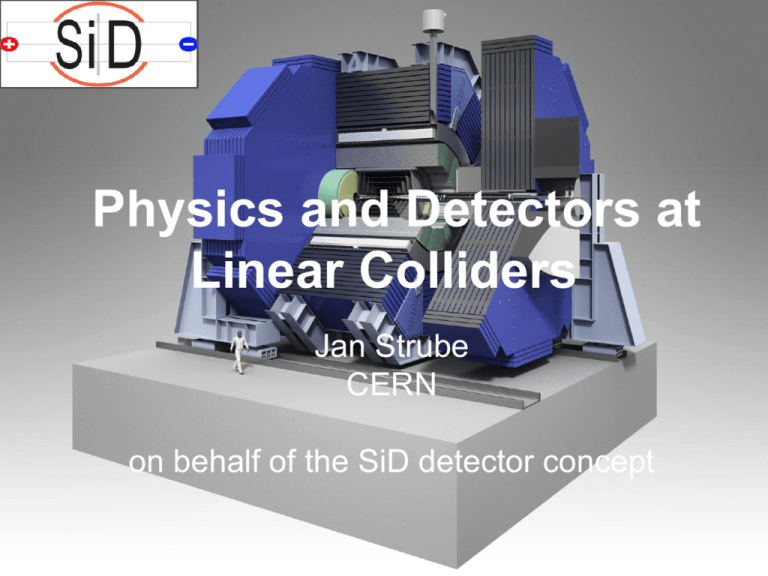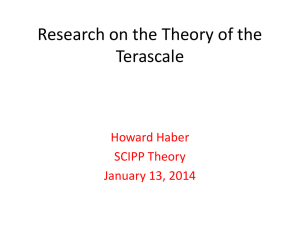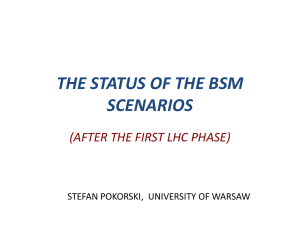Physics and Detectors at Linear Colliders
advertisement

Physics and Detectors at Linear Colliders Jan Strube CERN on behalf of the SiD detector concept Outline • • • • • • Physics Motivation The ILC Accelerator Requirements for Detectors SiD - a Detector for the ILC Simulation Studies Summary / Outlook The Higgs The Discovery of a Higgs Boson Measurements of Higgs Couplings Now... Focus changes from searches of Higgs bosons to measurements of Higgs properties: Spin Coupling to other Standard Model particles What else is there? “To me, it’s the ILC” Measurements of Higgs Couplings … in the future M. Peskin Extrapolation from Snowmass submissions. ILC has clear advantage in measurement of Higgs branching ratios to b, c and invisible. Total width directly accessible, measurements are absolute How well do we need to measure the Higgs boson couplings? A: It depends… see [Gupta, Rzehak, Wells, arXiv:1206.3560] for details ILC Physics Case ● Precision measurements of Higgs Boson properties and interactions with the rest of the Standard Model will be one of the cornerstones of particle physics for the foreseeable future ● The ILC offers significant and important advantages over existing facilities for Higgs physics ● Physics potential is maximized in staged construction, (91 GeV/)250 GeV - 1 TeV: SM precision, top, Higgs, SUSY The ILC accelerator Built in stages First stage: 250 GeV Baseline: 500 GeV Luminosity: 1.8 x 1034 cm-2s-1 Repetition rate: 5 Hz Undulator for positron production Superconducting technology: 8000 cavities, cooled to 2K Damping Rings Technology proven to work: FLASH (DESY) XFEL (DESY) Japanese Candidate Site Chosen Announcement on 23rd Aug. 2013: Kitakami site chosen for Japan’s bid to host the ILC Sites were scored on technical and sociological aspects ILC Machine Parameters ILC Beam Structure 1312 bunches, separated by 554 ns ● ● ● ● Beam structure allows high granularity design. Accumulate data during bunch train Read out in quiet time. No trigger needed: Expect one hadronic Z decay per train ● Background and radiation low compared to LHC. Allows to build low-mass tracking systems. The ILC Physics Program First Stage: 250 GeV ● Higgs recoil mass ● Higgs BR Second Stage: 500 GeV (baseline) ● Higgs BR ● Higgs width ● top physics (threshold scan) ● Higgs self-coupling Third Stage: 1000 GeV ● Top Yukawa coupling ● Maximum discovery potential for new physics Top threshold scan Unique feature of lepton colliders: Threshold scan Top mass at LHC: Pythia templates Translation to theoretically well-defined quantity difficult Top mass measured in threshold scan at ILC translates directly to well-defined MS mass. Δmtop < 100 MeV, dominated by theory uncertainty Higgs Physics at the ILC Higgs Physics at the ILC Higgs width Higgs Recoil method: First sensitivity to invisible decays Top Yukawa coupling Higgs BR: second generation fermions c quarks, muons Higgs selfcoupling: Recoil Mass measurement Reconstruct the Z boson Known √s Invariant mass of the recoiling event Unique capability of lepton colliders: Well-known initial state Reconstruct the Z boson, the invariant mass of the recoiling event peaks at the Higgs mass ZH → μ+μ- + anything, 250 GeV, 250 fb-1 ZH → μ+μ- + anything Physics Requirements 250 GeV Momentum resolution Higgs Recoil σ(pT)/pT2 ~ 2-5 x 10-5 GeV-1 W-Z separation Jet Energy Resolution Separation of W/Z/H bosons: Gauginos, Triple Gauge Coupling σ(E)/E = 3.5%-5% primary vertices in tth events Flavor Tagging Higgs Branching ratios σrφ ≈ 5 μm ⊕ 10 μm / (p[GeV] sin3/2θ) ILC 1 TeV Goals for Detector Design ILC environment allows to optimize for resolution Calorimeter Granularity: ~ 200x better than LHC Pixel Size: ~ 20x smaller than LHC Material budget, central region: ~ 10x less than LHC Material budget, forward region: ~ 100x less than LHC Motivation for Particle Flow Reconstruction High resolution is key to precision measurements Jet energy resolution W/Z separation perfect 3.1σ 5% 2σ 10% 1.1σ Goals: - equivalent luminosity - W / Z separation for gaugino analyses and anomalous triple gauge coupling measurement 10% Jet energy resolution 5% Jet energy resolution Introduction to Particle Flow Reconstruction I tracks Tracker: low material, high momentum resolution, high impact parameter resolution ECAL: - High number of radiation length (typically 15-30 X0) - good energy resolution (typically σE/E ≈ 5-20%/√E) HCAL: - High number of interaction lengths (typically 5-8 λ0) - good energy resolution (typically σE/E ≈ 50-100%/√E) Introduction to Particle Flow Reconstruction II Typical jet contents: 60% charged particles σ(pT)/pT2 ~ 2x10-5 GeV-1 30% photons σ(E)/E < 20% / √E 10% neutral hadrons σ(E)/E > 50% / √E Ideally, fully reconstruct the shower for each particle and match tracks to showers. At higher jet energies, confusion (mis-matching of energy depositions and particles) deteriorates the resolution. At even higher energies, leakages becomes a factor in the jet energy resolution. PFA possible without high granularity At CLIC: High granularity essential for background reduction Introduction to Particle Flow Reconstruction III Typical jet contents: 60% charged particles σ(pT)/pT2 ~ 2x10-5 GeV-1 30% photons σ(E)/E < 20% / √E 10% neutral hadrons σ(E)/E > 50% / √E 1. Find muons, subtract hits from calorimeter 2. Find tracks 3. Match tracks to clusters in the ECAL 4. Iterative re-clustering to ensure consistency between track and cluster energy 5. Remove hits matched to a track 6. Photon finding in the ECAL 7. Rest is neutral Hadrons SiD - A detector for the ILC Introducing SiD Co-spokesperson A. White UT Arlington Co-spokesperson M. Stanitzki DESY An international group studying a detector concept for LCs Home Institutions for Editors of the SiD Detailed Baseline Report The SiD Detector Concept at the ILC Flux return, instrumented for muon identification Highly granular SiW ECAL 10 layer silicon tracking system 5 layers pixel 5 layers microstrips ~ 2.5 m Highly segmented HCAL, 60 layers 5 Tesla field The SiD Detector Concept at the ILC A compact, cost-constrained detector designed to make precision measurements and be sensitive to a wide range of new phenomena Design Choices: - Compact Design in a 5 T field - Robust all-Silicon tracking with excellent momentum resolution - Time-stamping for single bunch crossings - Highly granular calorimetry optimized for Particle Flow - Integrated Design: All parts work in tandem - Iron flux return / muon identifier is part of SiD self-shielding Milestones Concept and its performance at various collision energies documented in several documents. SiD was validated by IDAG in 2009. The DBD The DBD The DBD describes the baseline choices for all sub-detectors (except the vertex detector) Options have been kept This baseline is fully costed Options offer better performance and/or lower cost Not as mature as baseline choices The DBD is a waypoint on the road to the SiD TDR and beyond. R&D continues. Overview of Detector Baseline Outer Tracker Low material budget ↔ excellent momentum resolution In an all-silicon tracker, this means: 1. thin sensors 2. advanced integrated electronics 3. low-mass support 4. low power ↔ low-mass cooling Hermetic coverage KPiX - System on a chip KPiX as a Calorimeter chip 1024 channels prototype under test - optimized for ILC (1 ms train, 5 Hz train repetition rate) • • • • • • Low noise dual range charge amplifier with 17 bit dynamic range Low noise floor 0.15 fC (1000 e−) Designed for power modulation, average power < 20 μW / channel Internal calibration system Up to four measurements per channel per train Versatile Baseline for Tracker and ECAL. KPiX as a Tracker chip First revision of pigtail cable has been tested. Second revision has been ordered. Tracking Performance Excellent momentum resolution, impact parameter resolution and track finding efficiency even in high-energy jets 5 Barrel layers Vertex Tracker Beam pipe Excellent impact parameter resolution for reconstruction of secondary and tertiary vertices Several technologies potentially meet the requirements: 3D, SOI, MAPS, hybrid pixels, DEPFET 5 pixel layers in barrel Innermost layer at 14 mm 4 disks ~ 20x20 μm2 pixels 3 forward disks ~ 50x50 μm2 pixels 3 Forward disks 4 disks R&D for extremely low-mass support structures: All-silicon assembly, foam-based ladders (PLUME collaboration), carbon fibre supports SiD is designed to make insertion and removal of the Vertex Detector straightforward. Allows to take advantage of the best possible technology. Pixel Technology Examples Prototype 2 pixel layout Chronopix: Monolithic CMOS chip with time stamp memory for a whole bunch train. 25x25 μm2 pixels currently, 90 nm technology. Full prototype to have 10x10 μm2 or 15x15 μm2, will go to 45 nm technology. 3D technology: Top interconnect can be done in final topside aluminum patterning with low mass. Cables bump-bonded to end of ladders. Allows for all-silicon design. Vertex Finding and Flavor Tagging performance Vertex detector to find decay point of long-lived particles (vertices): b and c quarks, τ leptons Flavor tagging is the identification of b, c or light quark jets. Calorimetry Tree Subsystem Absorber Readout Si-Pads ECAL Tungsten MAPS GEM HCAL Micromegas Steel RPC Muon System SiPM Steel SiPM Digital Readout Baseline Analog Readout Option RPC Si-W ECAL Highly segmented in lateral and transverse directions Hexagonal shapes Readout with KPiX chip 20 layers 2.5 mm W (5/7 X0), 10 layers 5 mm W (10/7 X0) 1.25 mm gaps → 29 X0, 1 λ ΔE / E ≈ 17% / √E Test in SLAC ESA beamline in July 2013, <15 of the full 30 layers; All layers for later running in 2013-14 The R&D provides the required baseline ECal components (except large-scale mechanics) – now nearly completed Digital HCAL ~ 500,000 channels World record for hadronic calorimetry 54 glass RPC chambers, 1m2 each PAD size 1×1 cm2 Digital readout (1 threshold) 100 ns time-slicing Fully integrated electronics Main DHCAL stack (39) + tail catcher (15) CERN test setup includes fast readout RPC (T3B) W-DHCAL π- at 210 GeV (SPS) HCAL in the Steel absorber stack at FNAL HCAL Highly granular calorimeter - 1x1 cm2 readout pads. World record for number of channels in hadron calorimetry already in test stack. Baseline: Glass RPC, digital readout Technology successfully tested in beam tests in steel absorber stack at FNAL and in tungsten absorber stack at CERN Data analysis is underway Operational experience drives further R&D: Single-glass RPC, low-resistivity glass for lower multiplicity, higher rate Energy resolution of pions all pions longitudinally contained Forward Systems LumiCal: 40 mrad < θ < 90 mrad - to measure integrated luminosity to better than 10-3 - read out by Bean, KPiX BeamCal: 3 mrad < θ < 40 mrad - to measure instantaneous luminosity using pairs - read out by Bean chip Bean Chip developed for higher radiation dose, high occupancy in far forward region 180 nm CMOS Solenoid Wes Craddock, SLAC, SiD Workshop, Jan. 2013 5 T coil with Detector Integrated Dipole (DID) Coil Design builds on CMS experience. Advances in computation give a significant advantage to the SiD design as compared to prior CMS design work - Magnetic field calculations in 3D ANSYS model - Conservative choice of material. Feasibility demonstrated. - Further conductor R&D could lead to cost savings. Muon Instrumented Flux Return. Main purpose: - Identification of muons - Rejection of hadrons 10 layers in barrel, 9 in each endcap Major change since LOI: RPC → Extruded Scintillator bars, SiPM readout Technology successfully tested in FNAL beam. Barrel Endcap Barrel: Double layers of orthogonal strips, glued together with aluminum sheets Endcap: Strip size adjusted to fit between spacers Wavelength-shifting fibers read out by SiPM in a mounting block Engineering and Push-Pull Horizontal access site SiD barrel fixed on 3.8 m concrete platform for pushpull Endcaps can be routinely opened for service Specific push-pull planning depends on IR layout "Fastest turnaround that is safely achievable": estimated 32 hrs Data Rates “Back-of-the-envelope” calculations: ● ILC 1 TeV: 1.06 GB / train data rate from detector, ~ 5.3 GB / s RAW data ● CLIC 3 TeV: ~ 200 GB / s RAW data from detector ~ 10 GB/s sustained data rate to be written to disk (using today’s EDM and file format and estimating potential for data reduction) ● LHC: Alice farm (2011) able to achieve ~ 5 GB / s sustained data rate to disk Farm size (CLIC 3 TeV): Estimated at 19k nodes of today’s nodes with today’s software. Size of CMS online farm (2011): 7.5k nodes Costing Costing units agreed between SiD, ILD, CLIC: 2008 USD SiD uses central values of agreed costs Cost of baseline: M&S: 315 MCU Contingency: 127 MCU Effort: 748 person-years • • • Parametric detector costing → cost sensitivity analysis Baseline: 6 CU / cm2 Si Coil costed as being made by industry 3 CU / cm2 Si, coil made inhouse, 6000 CU / m2 HCAL: M&S: 315 MCU → 222 MCU Detector Baseline Summary • SiD is designed for precision physics o • • • Designed to perform well in worse environment than planned Technological feasibility has been shown o Detailed studies ongoing SiD is fully costed o Solid foundation for a TDR All the cornerstones are in place o We're ready to start a TDR process SiD's Physics Performance Simulation SLIC - developed at SLAC Geometry definable at runtime XML file allows easy exchange of geometries between collaborators Now integrated in ILCSOFT • • • Centerpiece for the DD4HEP project to unify detector description for simulation and reconstruction Reconstruction Major change since LOI: Moving to common tools PandoraPFA: Calorimeter reconstruction and sophisticated Particle Flow Algorithms LCFIPlus: Vertex reconstruction and flavor tagging MarlinReco: Collection of analysis tools, e.g. isolated lepton identification New OverlayDriver to mix in two kinds of background • • • • Seamless transition enabled by the common LCIO format DBD Production in Numbers Production summary on SLAC confluence CPU time of different processing stages 50.7 million events at 1 TeV (+ 4.7 million gghadrons) 6.55 million events at 500 GeV (+ 4.4 million gghadrons) > 180 TB of data total detailed simulation dominates CPU time budget Total CPU Country Time (years) UK 100.2 CH 68.2 FR 15.0 US 28.2 TOTAL 211.6 SiD on the Grid Open Science Grid (OSG) resources are new addition to the SiD resource pool PNNL FNAL SLAC RAL Tier 1 dedicated resources: PNNL, SLAC, CERN temporary quota increase: FNAL, RAL Tier 1 opportunistic use: all others CERN Worldwide LHC Computing Grid (WLCG) resources have been established during LOI and CLIC CDR efforts SiD takes advantage of the international computing grid infrastructure DBD Benchmarking Analyses All analyses with detailed detector simulation SLIC with realistic (conservative) z distribution of events across luminous region Taking into account background from γγ interactions and incoherent pairs • • • Kinematic Properties of BeamInduced Background incoherent pairs ~ 450k particles / BX low energy, increase occupancy in forward region and inner tracking layers γγ → hadrons 4.1 events / BX reach the barrel detectors and have an effect on reconstruction Top Yukawa Coupling Dominant tth production diagrams Direct measurement of the top Yukawa coupling by measuring the tth cross section at 1 TeV analysis in 6-jet + 1 lepton and in 8-jet channel; candidates formed from jets by minimizing χ2 DBD Result: 13.2% cross section uncertainty in 6-jet channel 11.5% cross section uncertainty in 8-jet channel combined uncertainty on the top Yukawa coupling (1 ab-1): 4.5% with only Pe-, Pe+ = -80%, +20%: uncertainty about 4% Higgs Branching Ratios Measurement of the Higgs branching ratios to b, c, g, W, μ pairs (3 separate analyses) in direct production at 1 TeV Relative uncertainties on the cross section times Higgs BR Energy Luminosit y 1 TeV ℒ = 500 fb-1 ℒ = 1000 fb-1 P(e-) P(e+) − 80% + 20% h → bb 0.0065 0.026 0.0046 h → cc 0.100 0.733 0.071 Results do not take into account results from stages below 1 TeV. h → gg 0.040 0.234 0.028 h → WW 0.042 0.260 0.030 For example, h → cc at 250 GeV, 250 fb-1 ≈ 6 % h → μμ + 80% − 20% − 80% + 20% some analyses still being updated 0.32 quoted uncertainties statistical only Measurement of Beam Polarization e+e- → W+W- production in the forward region Sensitive to polarization, insensitive to new physics. Four jet topology: 0.8 < cos(θ) < 1 Two jets + lepton: 0.8 < cos(θ) < 1 and −1 < cos(θ) < 1 Δ|Pe−| Δ|Pe+| −80%,+20% 0.12 0.077 +80%,−20% 0.0046 0.023 sum 0.0020 0.0029 assuming 500 fb-1 in Pol. each polarization state Result: 0.8 < cos(θ) < 1 0.8 < cos(θ) < 1 assuming SM production of W +W- −1 < cos(θ) < 1 Top Pair Production at 500 GeV ILC Repetition of a LOI background with updated detector description: Measurement of top mass and forward-backward asymmetry in top pair production at 500 GeV. Reconstructed top mass in the fully hadronic channel. Result with 500 fb−1, Pe−, Pe+ = +80%, -30%: statistical uncertainty only - top production cross section: < 1% - measurement of forward-backward asymmetry: ± 2% Summary of Physics Performance • • • SiD baseline performance has been demonstrated in realistic simulation studies of precision measurements. Excellent b- and c-tagging as well as momentum and jet energy resolution allow to measure the Higgs couplings also to second generation fermions. Physics Performance with baseline has been studied up to 1 TeV. The SiD Detector Concept at CLIC Main differences wrt. ILC: - Larger rinner of the vertex detector - Tungsten absorber in HCAL - RPC-based muon system - More complex forward region - More precise time stamping in the active layers - Faster power cycling: 50 Hz Summary • • • • • The SiD concept is a compelling option for a detector at a linear collider The SiD concept (with appropriate adjustments of technology) has been successfully used for physics analyses in extensive simulation studies 250 GeV up to 3 TeV The DBD is a snapshot of the SiD road to a TDR R&D continues Now is an ideal time to contribute o Join the SiD Workshop, Oct. 15-17, SLAChttps://ilcagenda.linearcollider.org/conferenceOtherViews.py?confId=6161 o Join the SiD session at LCWS13, 14/11, 9.00-10.30 LCWS13 will be held at The University of Tokyo 11-15 November 2013 (registration is ongoing) http://www.icepp.s.u-tokyo.ac.jp/lcws13/ Thank you for your attention Backup







